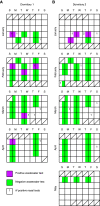Building-Level Detection Threshold of SARS-CoV-2 in Wastewater
- PMID: 36975999
- PMCID: PMC10100851
- DOI: 10.1128/spectrum.02929-22
Building-Level Detection Threshold of SARS-CoV-2 in Wastewater
Abstract
We established wastewater surveillance of SARS-CoV-2 in a small, residential, urban college as part of an integrated public health response during the COVID-19 pandemic. Students returned to campus in spring 2021. During the semester, students were required to perform nasal PCR tests twice weekly. At the same time, wastewater monitoring was established in 3 campus dormitory buildings. Two were dedicated dormitories with populations of 188 and 138 students; 1 was an isolation building where students were moved within 2 h of receiving positive test results. Analysis of wastewater from isolation indicated that the amount of viral shedding was highly variable and that viral concentration could not be used to estimate the number of cases at the building level. However, rapid movement of students to isolation enabled determination of predictive power, specificity, and sensitivity from instances in which generally one positive case at a time occurred in a building. Our assay yields effective results with an ~60% positive predictive power, ~90% negative predictive power, and ~90% specificity. Sensitivity, however, is low at ~40%. Detection is improved in the few instances of 2 simultaneous positive cases, with sensitivity of 1 case versus 2 cases increasing from ~20% to 100%. We also measured the appearance of a variant of concern on campus and noted a similarity in timeline with increased prevalence in surrounding New York City. Monitoring SARS-CoV-2 in the sewage outflow of individual buildings can be used with a realistic goal of containing outbreak clusters but not necessarily single cases. IMPORTANCE Diagnostic testing of sewage can detect levels of circulating viruses to help inform public health. Wastewater-based epidemiology has been particularly active during the COVID-19 pandemic to measure the prevalence of SARS-CoV-2. Understanding the technical limitations of diagnostic testing for individual buildings would help inform future surveillance programs. We report our diagnostic and clinical data monitoring of buildings on a college campus in New York City during the spring 2021 semester. Frequent nasal testing, mitigation measures, and public health protocols provided a context in which to study the effectiveness of wastewater-based epidemiology. Our efforts could not consistently detect individual positive COVID-19 cases, but sensitivity is significantly improved in detecting two simultaneous cases. We therefore contend that wastewater surveillance may be more practically suited for the mitigation of outbreak clusters.
Keywords: SARS-CoV-2; epidemiology; wastewater.
Conflict of interest statement
The authors declare no conflict of interest.
Figures


References
-
- Michael-Kordatou I, Karaolia P, Fatta-Kassinos D. 2020. Sewage analysis as a tool for the COVID-19 pandemic response and management: the urgent need for optimised protocols for SARS-CoV-2 detection and quantification. J Environ Chem Eng 8:104306. doi: 10.1016/j.jece.2020.104306. - DOI - PMC - PubMed
LinkOut - more resources
Full Text Sources
Miscellaneous

